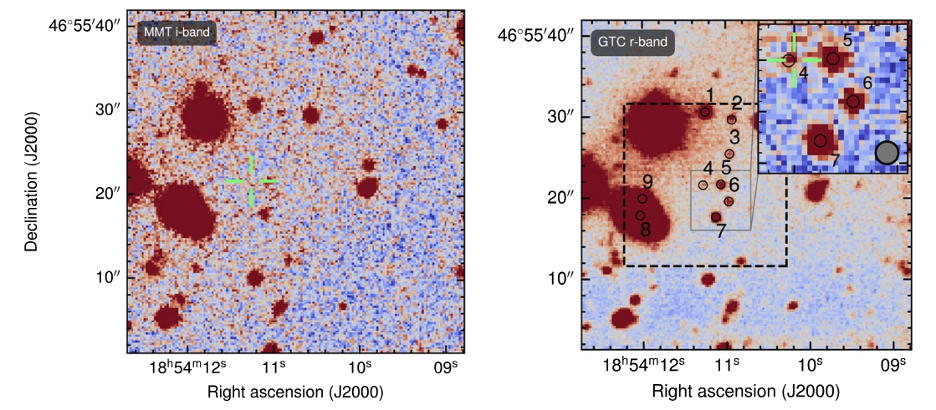
A repeating FRB in a low-luminosity dwarf galaxy
Danté Hewitt
FRBs are very short impulses of radio waves that originate from extragalactic distances. A small fraction of FRBs has been observed to repeat, but there is currently no statistically significant difference between the host galaxies of these repeaters and the (seemingly) non-repeaters (e.g., Gordon et al. 2023). In fact, the majority of FRB host galaxies identified so far are massive, star-forming galaxies (e.g., Sharma et al. 2024). This is consistent with an emerging picture that most FRBs might be produced by magnetars formed via core-collapse supernovae.
In the case of FRB 20190208A, initial optical observations with the 6.5-m MMT Observatory (down to a magnitude of about 26 mag), revealed no obvious host galaxy at the FRB position. Ultra-deep observations were then obtained with the 10.4-m Gran Telescopio Canarias (about 2 magnitudes deeper), revealing a faint source at the FRB position. Based on the dispersion measure (DM) of the bursts, the redshift of this faint source is estimated to be between z = 0.1 – 08, depending on the amount of DM contributed by the host galaxy. Consequently, the host galaxy of FRB 20190208A is at least a factor of a few, and potentially even more than an order-of-magnitude, less luminous than previously identified FRB host galaxies—on par with the Magellanic clouds.
Two other repeaters are known to be hosted in dwarf galaxies. Since dwarf galaxies do not contain much of the Universe’s stellar mass, the discovery of yet another repeater now in such a galaxy implies that perhaps certain environmental conditions—like the low metallicity—are conducive to the production of some FRB sources. Low metallicity allows for the formation of very massive stars, which, when they collapse, can lead to long gamma-ray bursts and superluminous supernovae. These extreme events may, in turn, produce magnetars capable of generating FRBs. This is further supported by the fact that the aforementioned two repeaters are also coincident with compact persistent radio emission, thought to perhaps be “hyper-nebulae” surrounding the central burst engines (Sridhar et al. 2022). The EVN observations of FRB 20190208A, however, ruled out the presence of a similarly luminous compact persistent radio source, further diversifying the FRB mystery.

The image on the left was taken with the 6.5-m MMT Observatory. The green crosshair indicates the EVN position of FRB 20190208A, determined from the PRECISE VLBI localisation; and also, no apparent host galaxy at this position (3σ limit of i > 25.7 mag (AB)). The image on the right shows the same field, but achieving 2 magnitudes greater depth, using the 10.4-m GTC. Various sources were identified and numbered in the dashed rectangular area. The inset is zoomed in on the region surrounding source 4, which is a faint (r = 27.32 ± 0.16 mag) galaxy, most likely associated (99.95%) with FRB 20190208A.
References:
Gordon, A.C., et al., 2023, ApJ, 954, 80
Sharma, K., et al., 2024, Nature, 635, pp. 61-66
Sridhar, N., et al, 2022, ApJ, 937, 5
Link to the paper:
Danté M. Hewitt et al 2024 ApJL 977 L4
Contact:
Danté Hewitt, Anton Pannekoek Institute for Astronomy, Amsterdam, NL. Email: d.m.hewitt@uva.nl